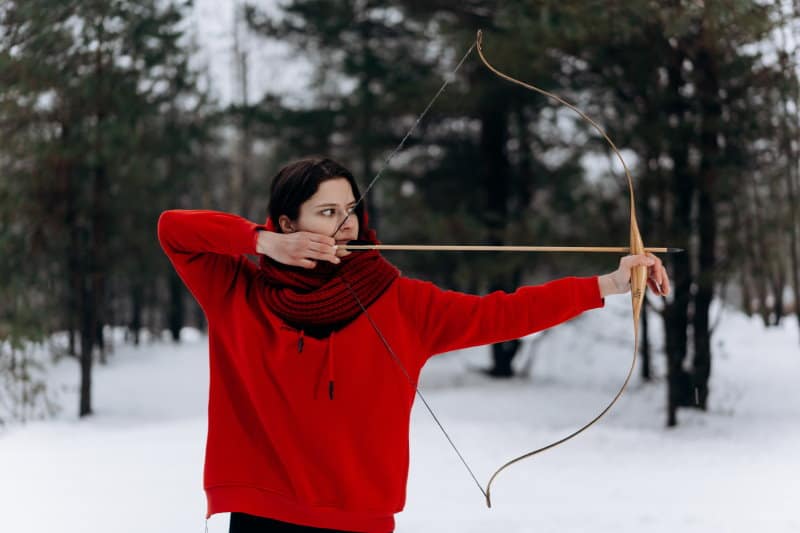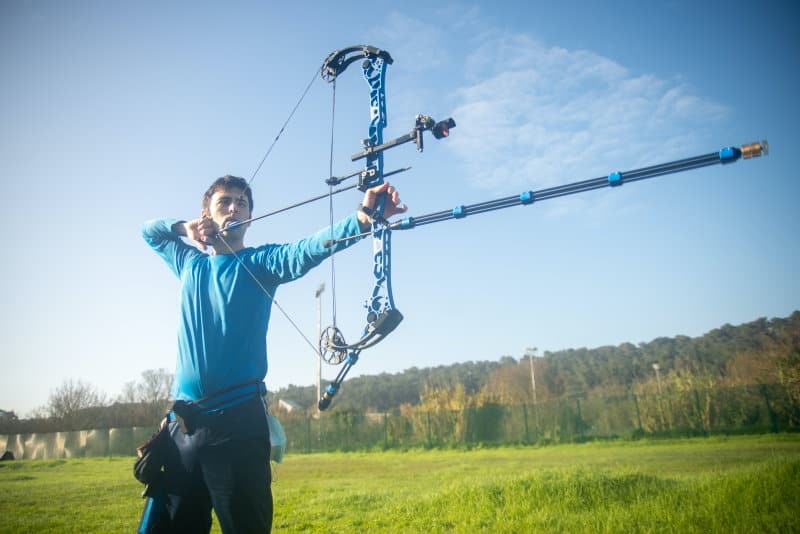Archery has been around for thousands of years. Consequently, archery bows have developed vastly over the years.
Whether you’re new to archery or not, you should know a thing or two about the different types of archery bows.
In total, there are five types of archery bows: recurve, longbow, compound, crossbow, and barebow. As a general rule, archers need to choose a bow based on their level of skill and archery style.
To help you know your bows better, we go through each of the five archery bows in detail. This way, you can enter the archery field with confidence.
1. The Recurve Bow

This is the oldest type of bow, as the first recurve bow was made in 800 B.C. This is why it’s sometimes called a “Classical Bow” as well.
Another reason for referring to a recurve bow as a classical one is that it’s the go-to bow for both beginner and professional archers.
As for the design of recurve bows, it’s quite simple. These bows are distinguished from the rest by their curves. That’s because they curl at the bow’s ends.
As a result, a recurve bow shoots with more efficiency and energy than other types of bows. An added plus is that they’ve got bigger handles for a better grip.
In addition, the limbs of recurve bows are made of carbon, wood, and composite materials. The handles are usually wooden, too, unless it’s a modern recurve bow. The former is often used by professionals as their metal handles are computer-designed. Either way, recurve bows are light and practical.
As a result of everything above, recurve bows are quite popular. Fun fact: the modern recurve bow is the only acceptable bow to use in Olympic sports. It’s also preferred for beginners with their shooting practice.
2. The Compound Bow

The main difference between compound and recurve bows is that compound bows are relatively new to the archery scene. The first one was made in the 1960s, in fact.
As a result of their modernity, the design of a compound bow consists mainly of pulleys, cams, and cables. This design gives the compound bow great technological advancement.
The pulley system is connected to the bowstring and attached to the wheels. In turn, this allows for a quick thrust of arrows. Overall, this intricate design aids the archer in drawing the arrow for as long as possible, thus allowing them to focus on aiming.
Not only that, but because they’re new, compound bows are built mainly from metal materials. By discarding the use of wooden materials, compound bows are more durable and long-lasting than fellow bows. They’re also less affected by the elements such as high temperatures and humidity.
As for the uses of the compound bow, there are quite a few. Compound bows are often used in Paralympic training due to their complex design. This is also why they’re not recommended for beginners. Hunters, on the other hand, prefer the compound bow because of its high accuracy, power, and draw weight.
ARTICLE. 5 compound #archery techniques you should study https://t.co/8HmwveTyf5
— World Archery (@worldarchery) December 13, 2021
3. The Longbow
The longbow originates back to medieval times, particularly around the 13th century. Since then, longbows were continuously used in battle until the late 16th century.
Because they’re so old, the design of longbows is almost primitive and has no need for complex materials or systems. But it’s this basic design that makes the longbow stand out from the rest.
A longbow is carved from wood and takes on a D-shape. The longer and thinner the D-shape is, the harder it is to shoot the longbow. The upside of this is that it increases their draw weight.
Besides, the longbow’s design lacks any technological additions. Meaning, accessories that can help with aiming such as arrow rests or sights, can’t be added to your longbow.
On the one hand, this makes them even harder to shoot with. On the other, it makes their shots stronger than other bows.
Don’t fear the longbow, though. Its simple looks can be deceiving, but it’s certainly an enjoyable challenge for archers. Mastering this bow will give you a sense of accomplishment. In fact, most professional archers use the longbow to hone their archery skills.
4. The Crossbow
The first record of a crossbow dates back to 600 B.C. when they were used by the Chinese in battle. Recently, however, archer technology has revamped the design and use of the crossbow. As a result, the crossbow has managed to mix between the traditional and modern.
Originally, crossbows had short limbs and lacked a riser. This helped archers make accurate aims on short distances.
Nowadays, crossbows come with a trigger design to release arrows faster. By use of a crank mechanism, arrows are locked into place until fired. This technology is the reason why crossbows are easy to handle.
When put up against its fellow technologically advanced bow, the compound bow, the crossbow can be quite different. For example, crossbows are only good for short-range shooting. Plus, without higher drawing weights, a crossbow’s accuracy will hardly match that of a compound one.
That being said, because most countries have legislation that limits the usage of crossbows to certain seasons, they’re not regularly used by archers. In reality, hunters have more use for a crossbow’s speed and strength than archery practitioners. Crossbows are also good for those who find it difficult to manually drawback arrows.
5. The Barebow
The barebow is a modernized version of a recurve bow. It was originally introduced to World Archery Field Championships in 1969. In recent years, however, the barebow was officially recognized as a competition bow. This is why it can be used in target archery too.
Having said that, the barebow has the same design as a traditional recurve bow, but without any sights, aiming marks, or any accessories to help with shooting.
The barebow is stripped to the ‘bare’ necessities needed by an archer. However, this doesn’t make the barebow any special as its strength and accuracy remain the same as a recurve bow.
In addition, barebows don’t have stabilizers as recurve bows do. As a result, they don’t swing after an arrow has been shot.
Plus, because they are bare, an archer should equip themselves properly so as not to harm their fingers, arms, or chest.
On the bright side, however, this raw approach to archery builds up their skill quickly.
Because of this, barebows are favored by archers who’d enjoy a distinctive method of archery and an intuitive approach to shooting arrows.
Their design also helps archers gain a better feel of the bow. Similar to longbows, barebows can also be difficult to master. All of this has contributed to the barebow being used in archery competitions.
Final Thoughts
There are five types of archery bows: recurve, compound, longbow, crossbow, and barebow.
Each bow is unique in its own way and has its own uses. Now that you know them all, it’s time to read about archery targets and how to maintain them.

